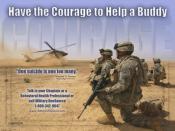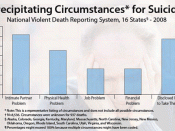Suicide is currently the third leading cause of death among teenagers in the United States, now said to be reaching epidemic proportions. It is estimated that 300-400 teenage suicides occur per year in the Los Angeles County alone; that's about 1 death a day.
Further statistics ⢠For every two homicides in the U.S. there are three suicides.
⢠Every hour and forty-five minutes another young person commits suicide ⢠Suicide is the 2nd leading cause of death among college students and the third-leading cause of death among youth overall (ages 15-24).
⢠Teen/youth suicide rates have tripled since 1970.
Ninety percent of adolescent suicide victims have at least one diagnosable, active psychiatric illness at the time of death most often depression, substance abuse, and conduct disorders and only 15% were in treatment at the time.
A lot of times teenagers have periods of self-doubt, feelings of inferiority and isolation.
Many suicidal youths experience family troubles, which lead them to doubt their self-worth and make them unwanted, misunderstood and unloved.
More signs include: Change in eating or sleeping habits, Hyperactivity, Being accident-prone, Physical complaints, Aggressiveness, Withdrawal, Sudden loss of interest in prized possessions, Apathy, anxiety, Overwhelming guilt or self-hate, Alcohol or drug abuse, Deep or prolonged grief over any loss.
These signs do not mean that someone is contemplating suicide, but they should alert one to explore the mind of a teenager more carefully.
Young people who are depressed and suicidal often hide those feelings at home and at school, although they may confide in their friends, often binding them to secrecy.
Question to class: If closest friend was seriously contemplating suicide and trusted you not to let anyone know, what would you do? What should be done if you suspect a teenager of having suicidal tendencies? The first thing is that you shouldn't be afraid to ask. An example of a question that should be asked is "Don't you sometimes feel so bad you think of suicide?" This question doesn't plant the idea or encourage it; it simply makes the person free to talk about it.
The second question should be something like (if the answer is yes.) "Have you thought how you might do it?" If the person has a definite plan, that means the means are easily available; the method lethal, and if the time is set; the risk of suicide is very high. Your response will be geared to the urgency of the situation as you see it. If you think there is immediate danger, do not leave this person alone. Stay with him/her until the crisis passes, or help arrives. If the person is hallucinating because of drugs or alcohol, then call someone to help you.
A number of myths and facts that should be known are as follows: Myth: People who talk about suicide don't kill themselves Fact: Eight out of ten suicides have spoken about their intent before killing themselves.
Myth: People who kill themselves really want to die.
Fact: Most people who commit suicide are confused about whether or not they want to live or die. Suicide is often a cry for help that ends in tragedy.
Myth: When people talk about suicide, you should get their minds off it, and change the subject.
Fact: Take them seriously; listen with care; give them the chance to express themselves, offer whatever help you can.
In conclusion, teenage suicide can be prevented if detected early. There are a number of hotlines that can be called for more information e.g. 1800 SUICIDE, 1800 668 6868.
A lot of teenager are desperately trying to find answers and frustrated that they cannot be found.
It is our responsibility to try and find these warning signs before its too late. It might just be someone close to us that are being affected right at this moment and we've just been too busy to notice.





